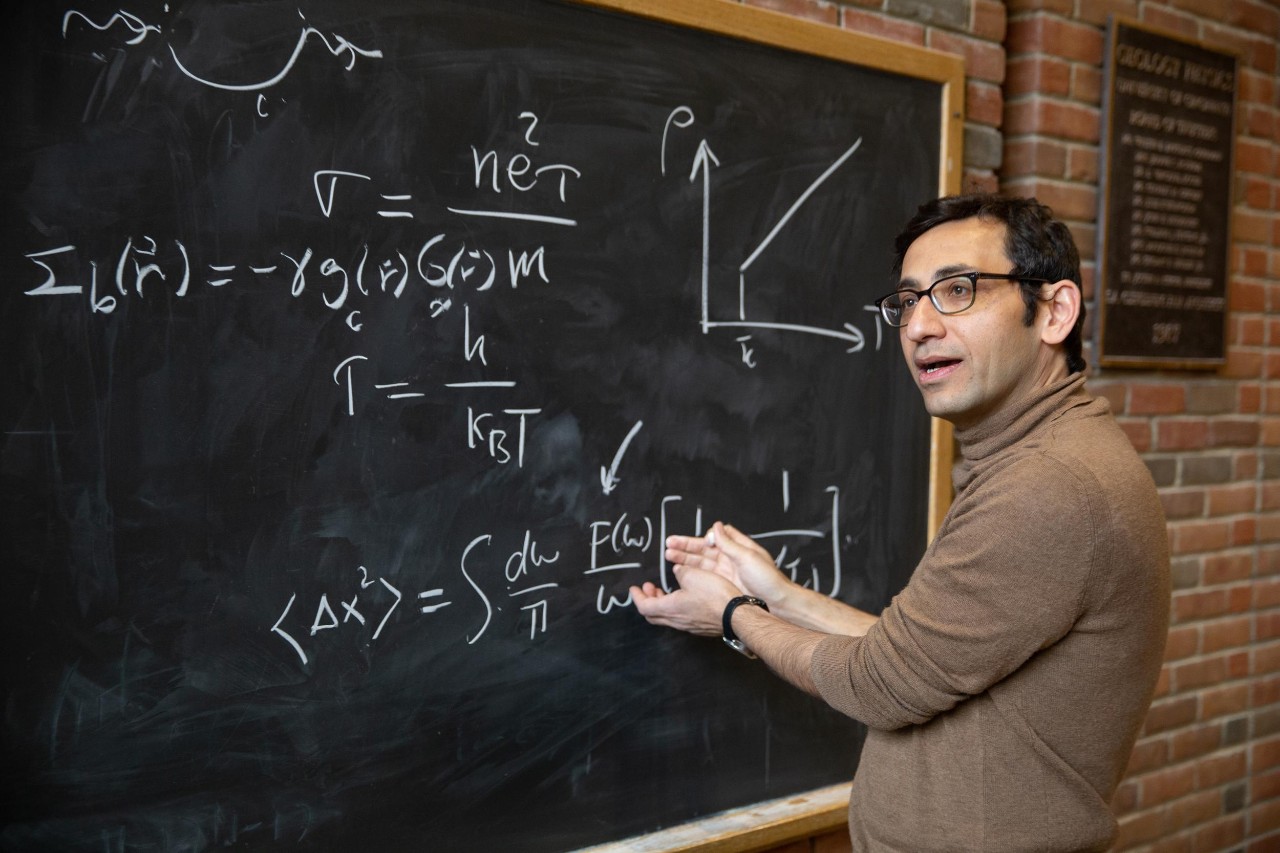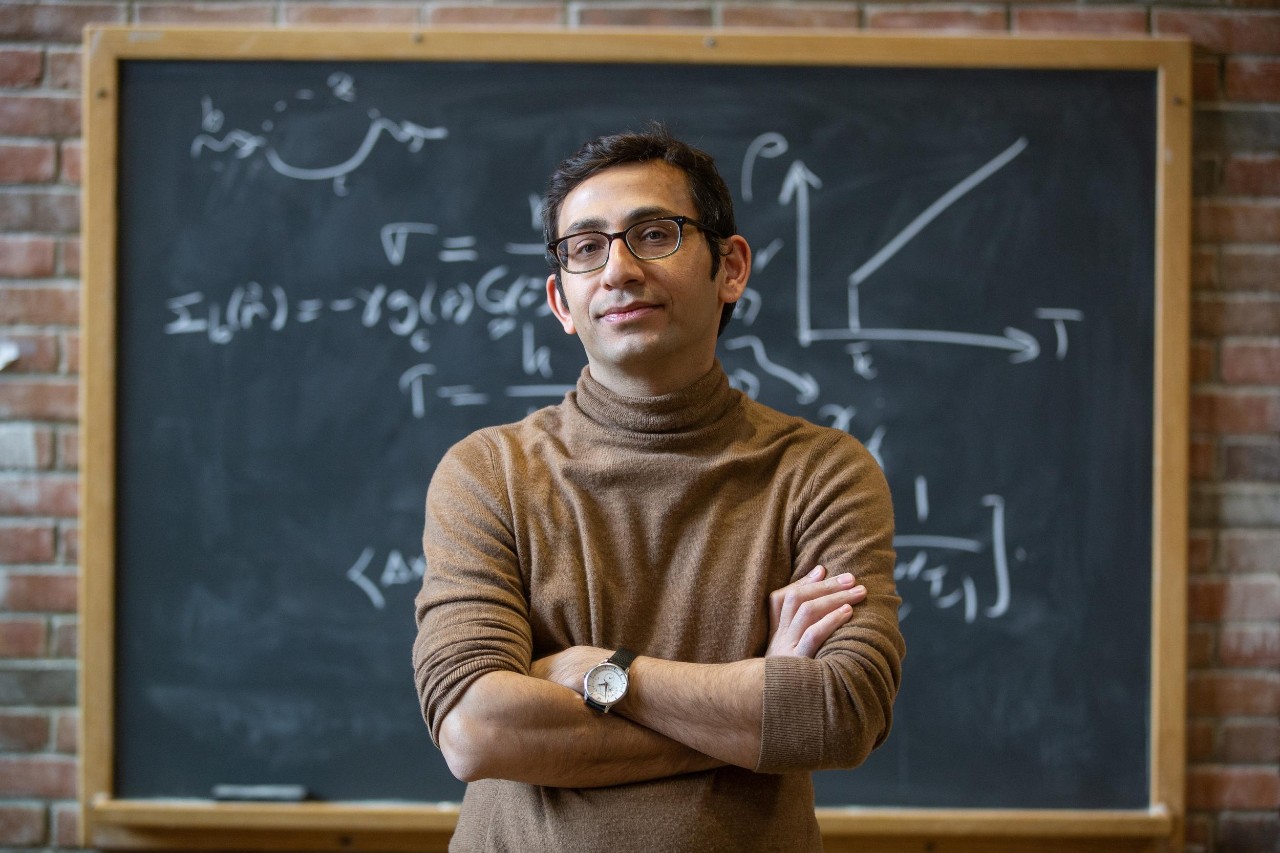
UC physicist explores mysteries of strange metals
International team finds unusual electrical behavior in experiments
Physicists at the University of Cincinnati are learning more about the bizarre behavior of “strange metals,” which operate outside the normal rules of electricity.
Theoretical physicist Yashar Komijani, an assistant professor in UC’s College of Arts and Sciences, contributed to an international experiment using a strange metal made from an alloy of ytterbium, a rare earth metal. Physicists in a lab in Hyogo, Japan, fired radioactive gamma rays at the strange metal to observe its unusual electrical behavior.
Led by Hisao Kobayashi with the University of Hyogo and RIKEN, the study was published in the journal Science. The experiment revealed unusual fluctuations in the strange metal’s electrical charge.
“The idea is that in a metal, you have a sea of electrons moving in the background on a lattice of ions,” Komijani said. “But a marvelous thing happens with quantum mechanics. You can forget about the complications of the lattice of ions. Instead, they behave as if they are in a vacuum.”

UC Assistant Professor Yashar Komijani worked with an international team of experimental and theoretical physicists to explore strange metals. Photo/Andrew Higley/UC Marketing + Brand
Komijani for years has been exploring the mysteries of strange metals in relation to quantum mechanics.
“You can put something in a black box and I can tell you a lot about what’s inside it without even looking at it just by measuring things like resistivity, heat capacity and conductivity,” he said.
“But when it comes to strange metals, I have no idea why they are showing the behavior they do. The mystery is why does the charge fluctuate so slowly in a strongly correlated quantum system?”
The mystery is why does the charge fluctuate so slowly in a strongly correlated quantum system?
Yashar Komijani, UC theoretical physicist
Strange metals are of interest to a wide range of physicists studying everything from particle physics to quantum mechanics. One reason is because of their oddly high conductivity, at least under extremely cold temperatures, which gives them potential as superconductors for quantum computing.
“The thing that is really exciting about these new results is that they provide a new insight into the inner machinery of the strange metal,” said study co-author Piers Coleman, a distinguished professor at Rutgers University.
“These metals provide the canvas for new forms of electronic matter — especially exotic and high temperature superconductivity,” he said.
Coleman said it’s too soon to speculate about what new technologies strange metals might inspire.
“It is said that after Michael Faraday discovered electromagnetism, the British Chancellor William Gladstone asked what it would be good for,” Coleman said. “Faraday answered that while he didn't know, he was sure that one day the government would tax it.”
Faraday’s discoveries opened a world of innovation.
“We feel a bit the same about the strange metal,” Coleman said. “Metals play such a central role today — copper, the archetypal conventional metal, is in all devices, all power lines, all around us.”
Coleman said strange metals one day could be just as ubiquitous in our technology.
“The big question about strange metals - is the origin of their scale invariance — their ‘quantum criticality,’” he said. “While the experimentalists are going to try to replicate our results on other strange metals, our team at UC and Rutgers will try to fold our new discovery into a new theory of the strange metals.”
The experiment was groundbreaking in part because of the way that researchers created the gamma particles using a particle accelerator called a synchrotron.
“In Japan, they use a synchrotron like they have at CERN [the European Organization for Nuclear Research] that accelerates a proton and smashes it into a wall and it emits a gamma ray,” Komijani said. “So they have an on-demand source of gamma rays without using radioactive material.”
Researchers used spectroscopy to study the effects of gamma rays on the strange metal.
Researchers also examined the speed of the metal’s electrical charge fluctuations, which take just a nanosecond — a billionth of a second. That might seem incredibly fast, Komijani said.
“However, in the quantum world, a nanosecond is an eternity,” he said. “For a long time we have been wondering why these fluctuations are actually so slow. We came up with a theory with collaborators that there might be vibrations of the lattice and indeed that was the case.”
The study was funded in part by the National Science Foundation and the Department of Energy.
Featured image at top: UC theoretical physicist Yashar Komijani is studying the properties of strange metals. Photo/Andrew Higley/UC Marketing + Brand
Next Lives Here
The University of Cincinnati is classified as a Research 1 institution by the Carnegie Commission and is ranked in the National Science Foundation's Top-35 public research universities. UC's graduate students and faculty investigate problems and innovate solutions with real-world impact. Next Lives Here.
Related Stories
Senior peer career coaches graduate with resumes ready
April 17, 2021
Profiles three senior peer career coaches in the University of Cincinnati's Bearcat Promise Career Studio
UC students recognized for achievement in undergraduate research
April 12, 2021
Undergraduate student researchers in sciences and humanities recognized in 2021
UC students recognized for achievement in undergraduate research
April 29, 2020
Each spring, the University of Cincinnati’s Division of Experience-Based Learning and Career Education (ELCE) honors students in experience-based learning programs.
Listen: Cincy Playhouse shares CCM audio plays
May 28, 2021
Each audio play is its own story, and you can listen to these pieces for free in any order you choose. They represent a year-long collaboration that reached into many corners of Cincinnati. Students from all over UC (CCM Acting, Sound Design, Stage Management, Commercial Music Production, Digital Media, and the College of Arts & Sciences’ Fiction PhD program) and local professional writers (YA author Liz Coley and musician, comedian and raconteur Paul Strickland) came together to make something truly special. Paul Strickland's play will be available soon. The Playhouse is assisting CCM by hosting and helping to promote these free audio plays.
UC staff have elected their 2021-23 Staff Senators
June 8, 2021
Join us in congratulating the 2021-23 new Staff Senate members! Elections were held in early May, and new senators will begin their two-year term in July 2021. All UC staff are encouraged to be part of the enthusiasm and excitement for our new senators by attending the Staff Senate online meeting via WebEx, June 30, 9-11 a.m.
UC LGBTQ Center founder takes on new diversity role
June 1, 2021
When Leisan Smith, ’99, ME ’03, began work this year as the inaugural chief equity officer at the prestigious Columbus School for Girls, the school’s staff and faculty were thrilled. The job description, they said, “was written for you.”
The making of a successful Faculty & Staff Campaign
May 25, 2021
More than one-third of UC’s nearly 7,000 faculty and staff have already contributed to the 2020-21 Faculty & Staff Campaign, putting the goal of 45% within reach.
Engineering student shifts from the stage to the lab
May 14, 2021
Garek Bushnell came to the University of Cincinnati with a singular goal: to study acting. He graduated in April 2021 with his bachelor’s degree in chemical engineering instead. Bushnell’s path between these two seemingly dissimilar fields is rooted in his mindset that following your passion will drive your determination to succeed – even if that passion comes from an unexpected source.
UC Foundation Board of Trustees elects six new members
May 11, 2021
The University of Cincinnati Foundation Board of Trustees has elected six new trustees to its 52-member board: Paul D. Green, BBA ’90; Lourdes J. Harshe, BBA ’92; Anndréa M. Moore, BBA’10; Arun C. Murthy, BBA ’95; Kirk L. Perry, BBA ’90, HON ‘15; and Christopher J. Van Pelt, BA ’91, MA ’93.
Three additional days off for UC employees
July 14, 2021
President Neville G. Pinto announced that UC employees will receive three additional days off in 2021 for going 'above and beyond' during the pandemic. The time away will take place during Winter Season Days.
